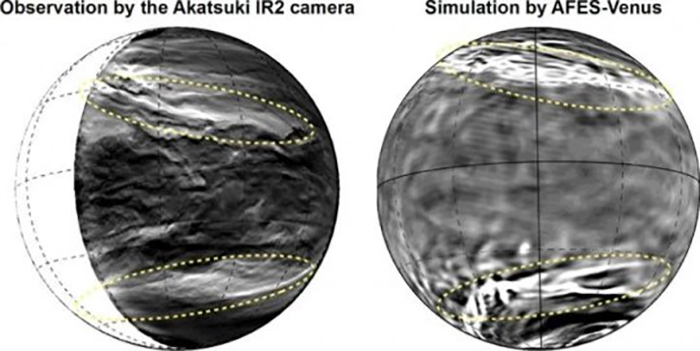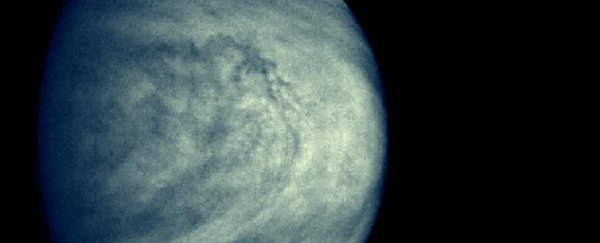Scientists have discovered mysterious streaking patterns crossing huge distances in the clouds of Venus.
The discovery is giving us new insight into the brutal conditions and climate on the strange planet second closest to the Sun.
Based on advanced computer modelling, the team thinks moving air caused by polar jet streams, similar to those on Earth, could be responsible for these irregularities – which can stretch some 10,000 kilometres (more than 6,200 miles) across.
The patterns are slowly coming into view thanks to the infrared scanning technology on board the Akatsuki space probe: it's able to peer beneath the thick clouds of sulfuric acid, 45-70 kilometres (28-43 miles) high, which usually keep the surface and lower cloud cover of Venus out of view of our telescopes.
 Venus clouds, observed and simulated. (Nature Communications)
Venus clouds, observed and simulated. (Nature Communications)
"Here we succeed, for the first time, in reproducing the patterns of the observed streak structure, as regions of strong downward flows that develop in high-resolution global simulations of the Venus atmosphere," explains the team of researchers.
While Venus and Earth share a similar size and gravitational pull, and possibly similar polar jet stream effects, their atmospheres are very different: think poisonous air, sulfuric acid rain, and scorching temperatures, which make landing a spacecraft on Venus very tricky.
There are also the high altitude 360 kilometre-per-hour (227 mile-per-hour) easterly winds that whip around the whole of Venus in the space of about four Earth days.
However, different layers of the Venusian atmosphere have different characteristics – it's just below these winds that the Akatsuki probe is managing to peer, mapping out the lower cloud shapes.
And discoveries like the giant streaks detailed here can tell us more about what's happening in the atmosphere as a whole. While we've seen certain parts of these patterns for decades now, this latest study adds a new level of detail, and a plausible explanation of what's actually causing them.
The scientists used advanced computer modelling to match the cloud patterns with test data and conclude that differences in air temperature and pressure (baroclinic instability), as well as the strong rotational winds mentioned earlier, are causing the streaking effect.
We've never seen patterns anything like this in the clouds on Earth, and the phenomena could be unique to Venus and its atmosphere.
The planet remains a fascinating subject to study for astronomers, whether it's figuring out the terrain patterns on the surface, or mapping the chaotic winds that whip up when the Sun goes down.
One day, we might be able to get much more accurate readings of what's happening on Venus – we just need to work out how to build electronics that can survive those surface temperatures of 460 degrees Celsius (860 degrees Fahrenheit).
Flying balloons in the cooler, calmer air above the clouds could be one way of taking a closer look at the planet.
For now, there's a lot more investigating to do – the team's model doesn't consider the effects of photochemical reactions and radiation levels, for instance – and you can expect to hear more from Akatsuki and the AFES-Venus computer simulation in the future.
"Though we have discussed a possible formation mechanism of the planetary-scale streak structure as above, we should note that the details of the disturbances, instabilities, and the angular momentum balance in our simulation are still unclear and remain to be explored," conclude the researchers.
The research has been published in Nature Communications.
